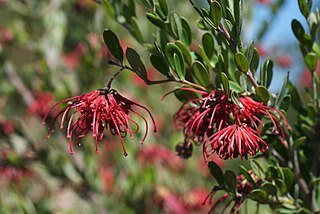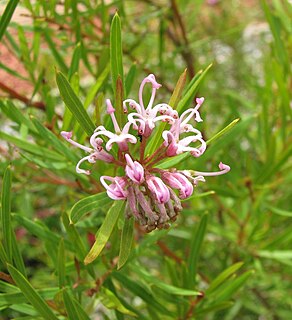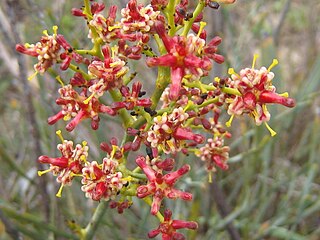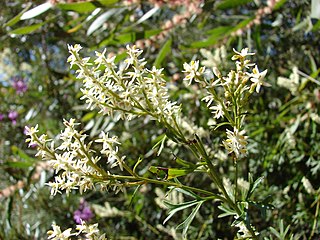
The Cyperaceae are a family of graminoid (grass-like), monocotyledonous flowering plants known as sedges. The family is large, with some 5,500 known species described in about 90 genera, the largest being the "true sedges" genus Carex with over 2,000 species.

Zygophyllaceae is a family of flowering plants that contains the bean-caper and caltrop. The family includes around 285 species in 22 genera.

The Restionaceae, also called restiads and restios, are a family of flowering plants native to the Southern Hemisphere; they vary from a few centimeters to 3 meters in height. Following the APG IV (2016): the family now includes the former families Anarthriaceae, Centrolepidaceae and Lyginiaceae, and as such includes 51 genera with 572 known species. Based on evidence from fossil pollens, the Restionaceae likely originated more than 65 million years ago during the Late Cretaceous period, when the southern continents were still part of Gondwana.

Grevillea is a diverse genus of about 360 species of evergreen flowering plants in the family Proteaceae, native to rainforest and more open habitats in Australia, New Guinea, New Caledonia, Sulawesi and other Indonesian islands east of the Wallace Line. It was named in honour of Charles Francis Greville, an 18th century patron of botany and co-founder of the Royal Horticultural Society. The species range from prostrate shrubs less than 50 cm (20 in) tall to trees 35 m (115 ft) tall. Common names include grevillea, spider flower, silky oak and toothbrush plant. Closely related to the genus Hakea, the genus gives its name to the subfamily Grevilleoideae.

Myoporum is a genus of flowering plants in the figwort family, Scrophulariaceae. There are 30 species in the genus, eighteen of which are endemic to Australia although others are endemic to Pacific Islands, including New Zealand, and one is endemic to two Indian Ocean islands. They are shrubs or small trees with leaves that are arranged alternately and have white, occasionally pink flowers and a fruit that is a drupe.

Grevillea speciosa, also known as red spider flower, is a shrub which is endemic to New South Wales in Australia.

Grevillea sericea, commonly known as the pink spider flower, is a shrub endemic to New South Wales, Australia.

Petrophile is a genus of evergreen shrubs, in the family Proteaceae. The genus is endemic to Australia. Commonly known as conebushes, they typically have prickly, divided foliage and produce prominently-displayed pink, yellow or cream flowers followed by grey, conical fruits.

Stirlingia latifolia, commonly known as blueboy, is a plant endemic to Western Australia.

Symphionema is a genus of two species of small shrubs in the family Proteaceae. Both species are endemic to New South Wales in Australia.

Grevillea arenaria is a shrub which is endemic to the east of New South Wales in Australia. It has an erect to spreading habit and grows to between 1 and 3 metres in height. Its leaves are 1.5 to 7 cm long and 3 to 15 mm in width. The flowers, which occur in groups of 2 to 10, are pink, red or orange, with green or yellow at the base and green styles. These occur year-round, with a major flourish in spring.
Banksia bipinnatifida subsp. bipinnatifida is a subspecies of Banksia bipinnatifida. As an autonym, it is defined as encompassing the type material of the species. It was known as Dryandra bipinnatifida subsp. bipinnatifida until 2007, when Austin Mast and Kevin Thiele sunk all Dryandra into Banksia. As with other members of Banksia ser. Dryandra, it is endemic to the South West Botanical Province of Western Australia.
Banksia fraseri var. fraseri is a variety of Banksia fraseri. As an autonym, it is defined as encompassing the type material of the species. It was known as Dryandra fraseri var. fraseri until 2007, when Austin Mast and Kevin Thiele sunk all Dryandra into Banksia. As with other members of Banksia ser. Dryandra, it is endemic to the South West Botanical Province of Western Australia.
Banksia plumosa subsp. plumosa is a subspecies of Banksia plumosa. As an autonym, it is defined as encompassing the type material of the species. It was known as Dryandra plumosa subsp. plumosa until 2007, when Austin Mast and Kevin Thiele sunk all Dryandra into Banksia. As with other members of Banksia ser. Dryandra, it is endemic to the South West Botanical Province of Western Australia.
Banksia pteridifolia subsp. pteridifolia is a subspecies of Banksia pteridifolia. As an autonym, it is defined as encompassing the type material of the species. It was known as Dryandra pteridifolia subsp. pteridifolia until 2007, when Austin Mast and Kevin Thiele sunk all Dryandra into Banksia. As with other members of Banksia ser. Dryandra, it is endemic to the South West Botanical Province of Western Australia.
Banksia squarrosa subsp. squarrosa is a subspecies of Banksia squarrosa, commonly called "pingle". As an autonym, it is defined as encompassing the type material of the species. It was known as Dryandra squarrosa subsp. squarrosa until 2007, when Austin Mast and Kevin Thiele sunk all Dryandra into Banksia. As with other members of Banksia ser. Dryandra, it is endemic to the South West Botanical Province of Western Australia.

Acidonia microcarpa is a species of shrub in the plant family Proteaceae. It is the only species in the genus Acidonia. It is endemic to the south coast of the Southwest Botanic Province of Western Australia.
Banksia nutans var. nutans is a variety of the plant Banksia nutans. It is native to the Southwest Botanical Province of Western Australia. As an autonym, its name is defined as containing the type specimen of the species.

Banksia sphaerocarpa var. sphaerocarpa is a variety of Banksia sphaerocarpa. It is native to the Southwest Botanical Province of Western Australia. As an autonym, it is defined as containing the type specimen of the species.

Tribuloideae is a subfamily of the flowering plant family Zygophyllaceae.













